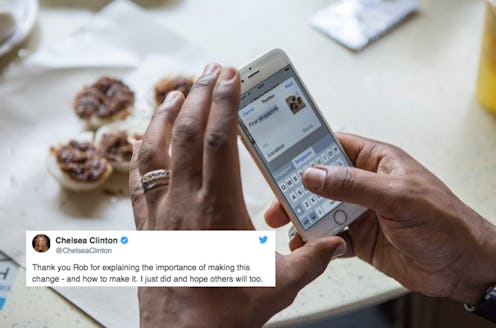Life
Here's How To Put Captions On Your Twitter Images To Make Them More Accessible For Blind Users

Twitter can often feel like an empty wasteland of doom, but I stick around for the funny tweets and memes. But what I didn't realize is how difficult the site can be for people with visual impairments who aren't able to see the images in their feed. Thankfully, there's a ridiculously simple fix: as Twitter user @_Red_Long pointed out in a tweet that's now gone mega-viral, Twitter offers a feature that lets you describe images in detail for people who are visually impaired that works with a screen reader. The tweet was posted on Jan. 3, and it racked up nearly 150,000 likes and 115,000 retweets in two days. The images in the tweet helpfully show how easy it is to caption caption Twitter images to make posts accessible for blind users.
So how do you turn on the feature? Because Twitter doesn't enable them by default, you have to do it manually. Open Settings & Privacy, then navigate to Accessibility. Check the box that says, "Compose image descriptions." Once you've turned the setting on, how do you use it? Ashley Bischoff, a copy editor who has written about the importance of image descriptions, gives this tip on her website: "Think of writing alt text for an image as if you’re describing the image to someone over the phone."
Basically, you use descriptive language to describe what's happening in a picture, and people who can't see the image are able to easily get an idea of what was posted when it's read through a screen reader. Rob Long, the Twitter user who made the original post, shared a follow-up video showing how image descriptions help blind or visually impaired people. "It makes a massive, massive difference to a blind or visually impaired Twitter user," he says in the video. The Royal National Institute of Blind People, a UK-based charity for sight loss, asked a question that other Twitter users also seem to have: Why aren't image descriptions automatically enabled? The answer isn't clear, but Long's tweet definitely helped spread the word. His tweet has nearly 4,500 replies as of Friday afternoon, and many of the responses are people saying they've enabled the feature.
Of course, retweets and replies from prominent people helped the instructions go viral. I first saw Long's tweet in my Twitter feed thanks to Chelsea Clinton and other celebrities like Lin-Manuel Miranda who shared it. I couldn't believe that I hadn't heard of the option before, especially because I regularly update my Twitter settings.
According to Twitter's help page about image descriptions, the description can be up to 420 characters. Once you post an image with a description, the text will only be visible to people using screen readers or braille displays, per Twitter. The company announced the feature nearly two years ago in March 2016.
On Bischoff's website, she shares examples of how to best describe various images. Here's one:
Here's the suggested description from Bischoff: "Two women stand in a museum, surrounded by sculptures. As one woman proposes to the other, placing a ring on the other woman's finger, an older woman who is sitting nearby looks on with an expression of sheer joy." Basically, the more detail you use, the better. If you're tweeting a picture of text — like a funny sign, a picture of an article, or a meme — Bischoff's guide recommends transcribing the text in the image description field.
It might take you slightly longer to compose a tweet, but it's clearly worth it. People with visual impairments will be able to read your posts, and it doesn't take much effort on your part. I'll be adding image descriptions to all of my tweets from now on — there's no excuse not to.